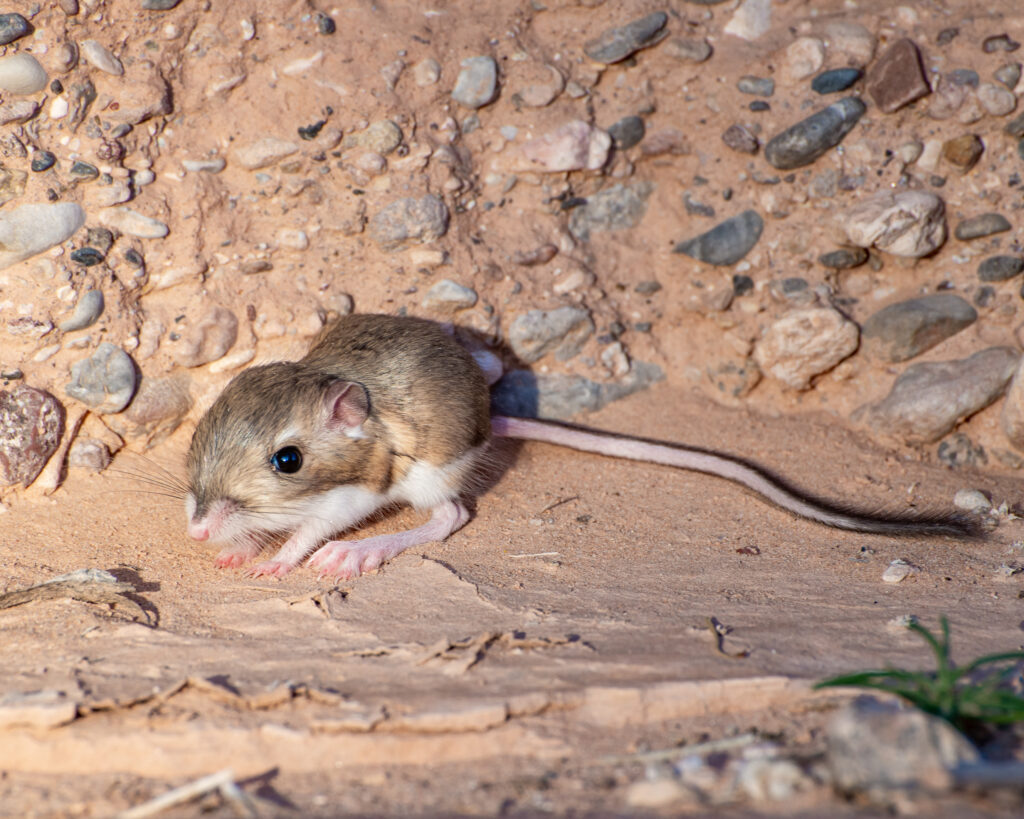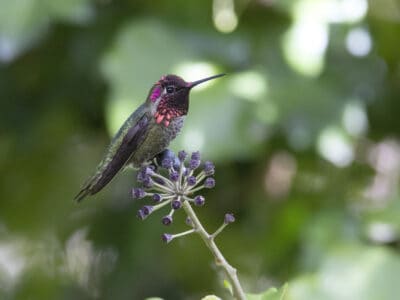Kangaroo Mouse
Microdipodops
The Kangaroo Mouse is a tiny mouse that stands and hops around on its hind legs, much like a kangaroo.
Advertisement
Kangaroo Mouse Scientific Classification
- Kingdom
- Animalia
- Phylum
- Chordata
- Class
- Mammalia
- Order
- Rodentia
- Family
- Heteromyidae
- Genus
- Microdipodops
- Scientific Name
- Microdipodops
Read our Complete Guide to Classification of Animals.
Kangaroo Mouse Conservation Status
Kangaroo Mouse Facts
- Name Of Young
- Pups
- Group Behavior
- Solitary
- Fun Fact
- The Kangaroo Mouse is a tiny mouse that stands and hops around on its hind legs, much like a kangaroo.
- Biggest Threat
- Unknown
- Most Distinctive Feature
- Long tail making up about half of the total body length
- Gestation Period
- 22-27 days
- Age Of Independence
- A few weeks
- Litter Size
- 3-8 pups
- Habitat
- Deserts
- Predators
- Owls, snakes, coyotes, foxes, and weasels
- Diet
- Herbivore
- Lifestyle
- Nocturnal
- Favorite Food
- seeds
- Special Features
- Large, "kangaroo" legs
- Number Of Species
- 2
- Location
- Southwestern United States
Kangaroo Mouse Physical Characteristics
- Color
- Brown
- Dark Brown
- Beige
- Skin Type
- Hair
- Lifespan
- 5 years
- Weight
- 0.4-0.6 ounces
- Height
- 1.8-2 inches
- Length
- 2.75-3.1 inches
- Age of Sexual Maturity
- 2 months
- Age of Weaning
- Around 21 days
- Venomous
- No
- Aggression
- Low
View all of the Kangaroo Mouse images!
Kangaroo Mouse Summary
The Kangaroo Mouse is native to the deserts of the southwestern United States. It is a tiny, nocturnal mouse with more giant hind legs, much like the Australian Kangaroo. It has a habit of bipedal locomotion by hopping about on its hind legs. There are two species of Kangaroo Mouse; both can be found in the state of Nevada.
Kangaroo Mouse Facts
- Kangaroo Mice live in the desert and rarely drink water. They get the water they need from the food they eat.
- Kangaroo Mice are nocturnal and spend the daytime underground in their burrow. Since they live in the desert, this is a survival adaptation due to the extreme daytime heat.
- Kangaroo Mice have large ears, which help them detect incoming predators.
- During winter (October-March), Kangaroo Mice will hibernate in their burrow underground.
Kangaroo Mouse Scientific Name
The Kangaroo Mouse is a mammal in the Mammalia class. It is in the Heteromyidae family and the Dipodomyinae subfamily. This family includes two Genera; Dipodomys includes 20 species of Kangaroo rats, and Microdipodops, which includes 2 species of Kangaroo Mice. The two species of Kangaroo Mice are:
- Pale Kangaroo Mouse, which has the scientific name Microdipodops pallidus, is also known as the “Soda Spring Valley Kangaroo Mouse.”
- Dark Kangaroo Mouse, which has the scientific name Microdipodops megacephalus, is also known as the “Owyhee River Kangaroo Mouse.”
Microdipodops is derived from a few ancient words. “Micro” is derived from the Greek word for small. “Dipod” is derived from the Greek word meaning “two legs.” “Ops” comes from the Latin word meaning “Plenty,” and Ops was the name of the fertility god in ancient Roman religion.
Kangaroo Mouse Appearance
The Kangaroo Mouse looks like a typical mouse with a few distinguishing features. They have large hind legs that they typically stand on like a kangaroo. Their fore legs are proportionately small, their fur is long and silky, and they have a long, slim tail with fur at the end that helps them balance when standing and hopping on their hind legs.
The average Kangaroo Mouse is 160 mm in total length, or about the length of a typical ink pen. The length of the tail averages about 84mm, which makes their body and tail overall about the same length. The average weight of a Kangaroo Mouse is about 13.5 grams, slightly less than the weight of three US 25-cent coins. Their rear foot is about 25 mm long.
As you can see, their rear foot is large proportionately to their body and is about 1/3 the length of their entire body. Their head and ears are proportionally large to their body, so overall they appear to be one round furry ball with large hind feet and a long tail.
The difference between the dark and pale Kangaroo Mice is the color of their fur as the names suggest. The dark Kangaroo Mouse has dark brown fur, and the pale Kangaroo Mouse has lighter, pale brown fur. The fur colors help camouflage the mice against their backgrounds in specific regions.

The long tail, used for balance, makes up about half of the Kangaroo Mouse’s length.
©Dominic Gentilore PhD/Shutterstock.com
Kangaroo Mouse Behavior
Kangaroo Mice live alone and are independent of others of their species. They live in burrows and spend much of their time there. The mice have their young in the burrow, store food in it, and only leave at night under the right conditions to forage for food.
They typically hop around on their two hind legs but sometimes may walk on all four. They forage for seeds mixed into the soil and collect them into external cheek pouches. The seeds are hoarded in the burrow and only shared with dependent young.
Kangaroo Mouse Habitat
Kangaroo Mice live in the southwestern deserts of the United States. The Dark Kangaroo Mouse can be found in California, Idaho, Nevada, Oregon, and Utah. The Pale Kangaroo Mouse can be found in California and Nevada.
Kangaroo Mice live underground in burrows between 3 feet to 8 feet long. They use the burrows in the winter to protect them from the cold, and during the summer, they stay in them throughout the day to protect them from the desert heat.
Kangaroo Mice are nocturnal, and their eyes are susceptible to light, so they can see best in very dark environments. This is both a survival and a defensive adaptation. The desert heat and sun are scorching, so they only leave the burrow two hours after sunset. They also avoid nights with bright moonlight, and this prevents them from being easily spotted by predators.
Kangaroo Mouse Diet
Kangaroo Mice eat mainly tiny seeds from the vegetation and shrubs in the Sagebrush scrub zone of the southwestern US deserts. In the summer, they may consume insects as well.
They do not drink water, so they do not have to live near a water source. They have efficient kidneys and can metabolize all the water they need from their food. Since they are not active in the winter, they store food in their burrows.
Some are known to have food stored in multiple locations in case an intruder compromises their burrow. During the summer, their body stores fat from the food they eat in their tail.
Kangaroo Mouse Predators, Threats, and Conservation Stats
The Kangaroo Mouse populations are plentiful and are listed as the least concern by the IUCN. Their populations are believed to be declining; however, since they live in remote regions of the desert, their habitat destruction is currently not seen as an issue.
The main predators of the Kangaroo Mouse are owls, weasels, rattlesnakes, foxes, badgers, and coyotes. Most of these predators will use an ambush method to capture the mice.
Since the mice are only active during dark nights and use their burrows for safety, actively hunting them can prove challenging. The Kangaroo Mouse also has sensitive ears, so they can hear predators coming in the dry desert environment.
What eats Kangaroo Mice?
Predators of Kangaroo Mice include owls, weasels, rattlesnakes, foxes, badgers, and coyotes.
What do Kangaroo Mice eat?
Kangaroo Mice eat mainly seeds and sometimes insects.
Kangaroo Mouse Reproduction, Babies, and Lifespan
Not much is known about the mating specifics of Kangaroo Mice. Since they mainly live in their burrows, any mating rituals and the young can not be observed. After the winter hibernation and early spring, Kangaroo mice begin breeding. They are promiscuous, with multiple males mating with multiple females.
Pregnant females have been observed from the early spring to early fall, so it is thought that they have multiple litters per season. The gestation period is between 22 to 27 days, and the females will have 2 to 7 young at a time. The females will feed and care for the young until they are old enough to leave the burrow, which is thought to be just a few weeks.
The average lifespan of an adult is about 5.4 years.
Kangaroo Mouse Population
Population data for Kangaroo Mice is not known. It is thought that their populations have been decreasing over the past few years due to agricultural development. Since they live in remote regions of the southwestern US desert, their conservation status is not a concern.
Similar Animals to Kangaroo Mice
Kangaroo Mice are similar to the Kangaroo Rats that make up their sister Genera. They are also similar to the Hopping mouse, native to Australia, and the Springhare, native to southern and eastern Africa.
View all 77 animals that start with KKangaroo Mouse FAQs (Frequently Asked Questions)
What are the predators of the Kangaroo Mouse?
Predators of Kangaroo Mice include owls, weasels, rattlesnakes, foxes, badgers, and coyotes.
Thank you for reading! Have some feedback for us? Contact the AZ Animals editorial team.
Sources
- Wikipedia, Available here: https://en.wikipedia.org/wiki/Kangaroo_mouse
- The Naturalist, Available here: https://www.inaturalist.org/taxa/44162-Microdipodops-megacephalus
- Wikipedia, Available here: https://en.wikipedia.org/wiki/Pale_kangaroo_mouse
- Wikipedia, Available here: https://en.wikipedia.org/wiki/Dark_kangaroo_mouse
- Animal Diversity Web, Available here: https://animaldiversity.org/accounts/Microdipodops_megacephalus/

















